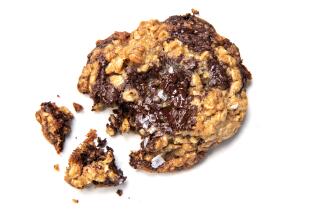Plain Old Eating Right Can Keep You Young
So the fountain of youth is a fairy tale and all those creams and lotions don’t do much. Isn’t there something you can do to at least slow the aging process? Yes, say dietitians. Just look in your kitchen.
“Diet plays a role in how quickly or slowly we age,” says Cindy Daversa, a registered dietitian at St. Jude Medical Center in Fullerton. Eat certain foods and avoid others, and you may actually slow the aging process.
“The main theory on why we age says that aging is caused by DNA damage to cells by free radicals,” Daversa says. “Free radicals are byproducts of oxidation, which occurs naturally because of environmental pollutants and the consumption of certain foods.
“These unstable molecules damage DNA by banging on cell walls and destroying cell membranes, which leads to aging.”
The good news is that certain vitamins and minerals are free-radical scavengers. Known as antioxidants, Vitamin E, Vitamin C, beta carotene and the mineral selenium tie up the unstable molecules and keep them from doing damage.
To live as long and healthy a life as possible, it’s important to watch your diet. To do so, keep the following tips in mind:
* Eat foods rich in antioxidants.
The following fruits and vegetables contain Vitamin C and/or beta carotene: cantaloupe, persimmons, strawberries, oranges, grapefruit, tangerines, peaches, apricots, kiwi, mangoes, papaya, pomegranate, pumpkins, sweet potatoes, yellow squash, carrots, spinach, kale, collard greens, Swiss chard, tomatoes, Brussels sprouts, broccoli and green/red/yellow peppers.
To get adequate amounts of the antioxidants Vitamin E and selenium, eat whole-grain breads and cereals.
“Check the bread bag or cereal box and make sure that the first ingredient is a whole grain,” Daversa says. “This is important because when they process wheat, they remove the germ, which contains a lot of vitamin E.”
Look for labels that say “whole wheat flour,” not “unbleached wheat flour” or “enriched wheat flour,” which have been processed.
* Also try seafood such as bass, halibut, trout, cod, red snapper, swordfish, shark, catfish and salmon.
Salmon is also high in Omega 3 fatty acids, which some studies have shown help keep arteries clear. You also can eat shellfish such as scallops, shrimp, lobster and crab, but keep consumption of this type of fish to three ounces a day, because these tend to be high in cholesterol, Daversa says. (Three ounces is about the size of a deck of cards.)
* Enjoy poultry such as turkey, chicken and Cornish game hens. Just remember to remove the skin, which is all fat, and keep in mind that white meat such as chicken breast has half the fat of dark meat such as legs. “Dark meat is still OK, though,” Daversa says. “Just compensate by cutting down on other fats in your meal like salad dressing.”
Eat eggs, but no more than three times a week. “The yolks are high in Vitamin E and selenium,” Daversa says.
Other good sources of Vitamin E include liver, green leafy vegetables, nuts, milk (nonfat or 1% fat is preferable) and oils, says Lisa Gibson, a registered dietitian in Irvine.
Good foods from which to get selenium are mushrooms, onions and garlic, Daversa says.
* Avoid fat, especially certain oils.
“While oil does contain Vitamin E, research has shown that polyunsaturated oils can actually cause free-radical formation,” Daversa says.
Polyunsaturates include margarine and oils such as safflower, soybean and corn.
“These oils have double bonds, which are points of weakness in the oil’s structure; when oxygen in the body spots them, it goes directly to break them up, causing free radicals.”
For oil, use canola, which is monounsaturated. This means it has only one bond, which makes it less likely to become oxidized and cause free radical formation; it also contains Omega 3 fatty acids.
Some experts suggest replacing margarine with the saturated fat butter. Butter contains the same amount of fat as margarine and has no double bonds, so it isn’t as likely to cause free-radical damage.
It is high in cholesterol, though, so keep your intake to two to three teaspoons a day. As a guideline, fewer than 30% of your daily calorie intake should be from fats.
* Maintain a desirable weight.
Being overweight puts you at risk for several life-threatening conditions such as diabetes, high cholesterol and high blood pressure. If you do lose weight, however, make sure to keep it off, because yo-yo dieting is even worse for you, Gibson says.
For those who are underweight, there is good news. Although experts once thought that being thin was unhealthy, they’ve recently discovered otherwise, Gibson says.
“If you factor out people who are thin because of illness, it’s actually an advantage to be on the thin side,” she says. “Individuals who are 11% to 20% below average weight are at a lower risk.”
Daversa concurs. “When researchers visited tribes in other countries where the people live longer and more healthier lives, they found that they had body weights slightly under what we consider average.”
In light of this knowledge, researchers have been feeding low-calorie diets to rats. “The studies have shown that if you feed rats 40% fewer calories, they live 50% longer than those rats that are fed more,” Gibson says.
* Avoid smoked and cured meats.
Sausage, pepperoni, many luncheon meats, hot dogs and other similar meats contain nitrates and nitrites, which have been found to increase free radical formation and cause cancer, Daversa says.
* Don’t rely on supplements.
Most experts will tell you to get your antioxidant vitamins and minerals through food, not pills. They advise this because not only does food provide you with other nutrients and fiber that a pill can’t, but also because it’s possible to overdose on certain vitamins.
Taking too much Vitamin C, for example, won’t harm you because it’s water soluble and flushes out of the body, but too much Vitamin A can be a problem. It is stored in the liver, where it can reach toxic proportions if too much is taken.
Symptoms of a Vitamin A overdose include headaches, blurred vision, fatigue, diarrhea, joint and bone pain, appetite loss and dry skin, Daversa says.
Because of the danger, experts suggest that you not take Vitamin A supplements without a doctor’s recommendation. Selenium is only needed in small amounts, so a supplement of this should not be taken either.
If you want to take supplemental Vitamin C (a good idea for cigarette smokers, because smoking increases free-radical formation and also robs the body of this vitamin), don’t take more than two to three times the recommended daily allowance of 60 milligrams, Daversa advises.
As for Vitamin E supplements, the jury is still out.
“Although it is a fat-soluble vitamin, some nutrition experts believe in taking Vitamin E,” Gibson says. “One reason is that 65% of the Vitamin E consumed in American diets is through dressings and oils. They reason that if you cut down on fat, you cut down on Vitamin E consumption, so supplementing is necessary.”
“Studies have been done on taking as much as three times the recommended daily allowance of Vitamin E, and no harmful effects have been shown,” Daversa says.
* Exercise.
“Inactivity is as great a risk factor for premature death as high cholesterol,” Gibson says. “As we age, it’s normal to gain fat and lose muscle strength and aerobic capacity. Exercising slows down this process.”
Do some sort of aerobic exercise and strength training at least three times a week.
* Start now.
“Don’t wait until you have problems to adopt an anti-aging diet,” Daversa says. “It takes a while for poor eating habits to show. Someone who eats badly now may look OK, but a poor diet will show 10 years from now.”
No matter what age you are, it’s never too late to change your diet and exercise, Gibson says. “Watch what you eat and start walking. It’ll make a great impact on your life.”
More to Read
Eat your way across L.A.
Get our weekly Tasting Notes newsletter for reviews, news and more.
You may occasionally receive promotional content from the Los Angeles Times.






